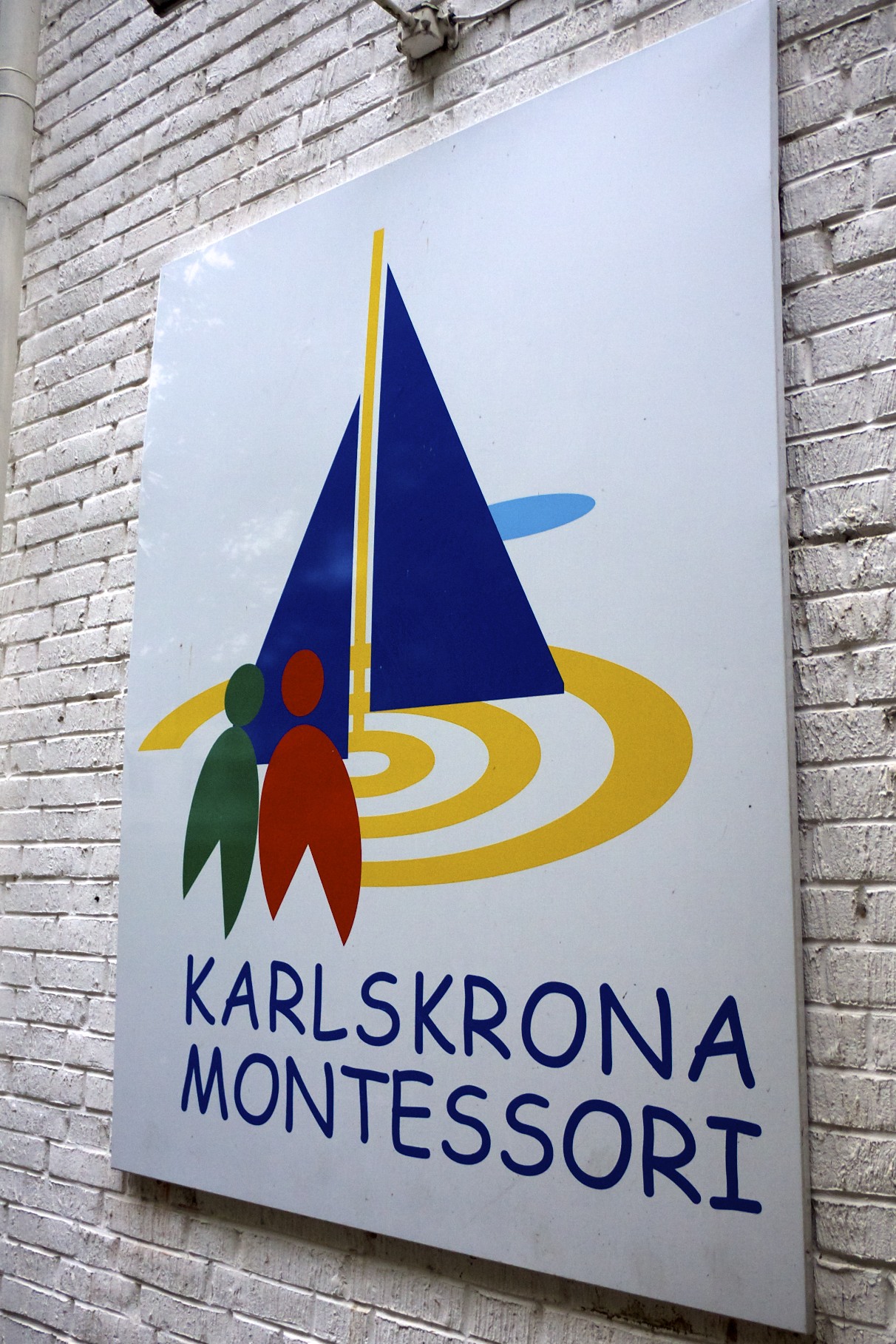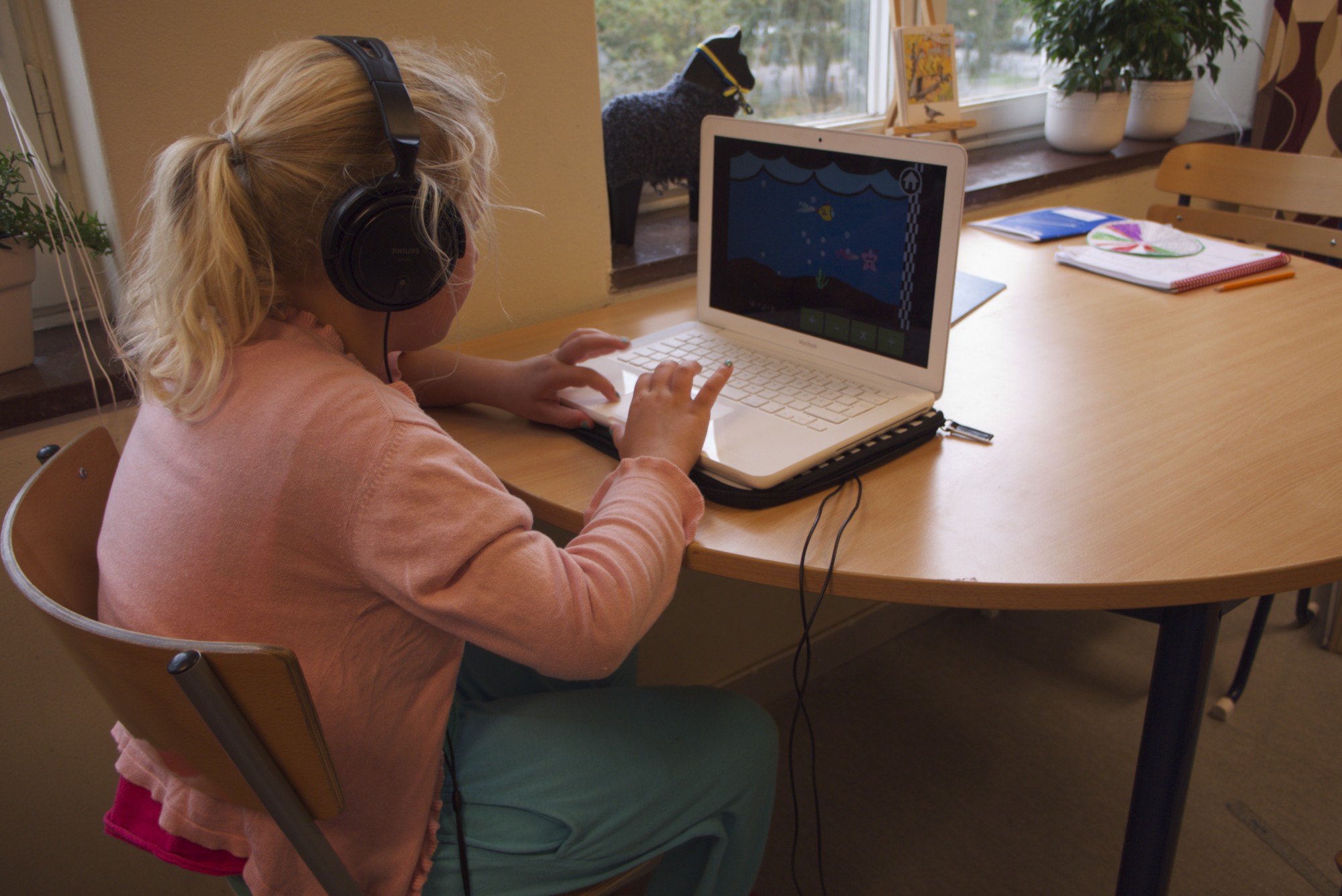
During our free time in the bridal shop, Lotta (aka my colleague/friend) and I would chat a lot about differences between Sweden and Singapore. And one of the heavily discussed topics about the two countries must be the education system. Lotta's daughter, Saga is studying grade 3 in Karlskrona Montessori and she often shares with me how Saga loves going to school and all the interesting stuffs she does in school. And just two weeks ago, Lotta was very kind to bring me to Saga's school so that I could see for myself how lessons are like in Swedish schools. The school encourages parents to spend an entire day or two following their children through their lessons to understand what the children are doing in school.
Upon reaching the school, I was greeted by Saga's best friends but were all too shy to talk to me. lol. Still, they played very good host and led us around the school throughout the day. Lessons started at 8am and the children changed into comfortable home slippers upon arrival. I love this idea! Not only did it keep the floor clean, it made the children feel more at home and more relaxed immediately!
We went up to the second floor to Saga's third grade classroom and her two teachers were at the door to greet and welcome the children. There are 25 students in her class and this gives an impressive student-to-teacher ratio of 25 to 2 or 12.5 to 1! It is not just in Montessori that they have low student-teacher ratio. In other Swedish public schools, the number of students per teacher per class are capped at 25.
The classroom lights were dimmed and relaxing music was playing in the background. The children gathered around this 'cozy corner' of the classroom and excitedly whispered to their friends while waiting for the lesson to start.
 The teacher then joined the circle and asked about their day and how they were feeling, basically just chit-chatting with the children. It was a great idea to begin the day making every kid feel relax and happy.
The teacher then joined the circle and asked about their day and how they were feeling, basically just chit-chatting with the children. It was a great idea to begin the day making every kid feel relax and happy.
At 8.15am, the 25 students split into two groups of 12 and 13. One group was having a Geometry Math lesson and the other was learning about living things in a Science lesson. Their classroom can be separated into two smaller rooms by the doors in the centre, so they can have two lessons going on concurrently.

During the Science lesson, the students walked around the class looking at pictures and had to decide if they were living things or not. The students gathered back in the circle for a discussion. For every picture, the teacher went round the class and asked every student to state if it was a living thing or non-living thing and explain why. I understood now why they further divided the (already very) small class into smaller groups of 12 and 13 - every child get to speak and share his/her opinion.

The Science lesson ended at 9.15am. From 9.15 to 10.30am, it was 'free time' for the students. Honestly, when I heard free time, image of a class with no teacher and children playing a fool, sleeping, screaming, doing nothing etc flashed past. Read: All hell break loose. But what I saw was far from my imagination.
Every student had done an individual weekly plan at the beginning of the week. When the teacher announced that they were free to do what they want, they looked through their list, chose the task and proceeded to complete the task. This was what Saga did in the 1h 15 minutes of free time:
1) Saga had a discussion with her friends about their school newsletter project.

2) She completed her 3 pages of her Math homework and placed the book in a homework box for the teacher to check.
 3) She did 25 multiplication questions, timed herself and recorded the time down on the worksheet.
3) She did 25 multiplication questions, timed herself and recorded the time down on the worksheet.4) She went to the resource shelf and took a list of 5 Swedish words to learn pronunciation. According to the instruction on the list, she has to practice the words on her own, then repeat the words to a friend and finally to a teacher.
And the impressive thing was that she did everything without any instructions from the teacher! Everyone knew very well the tasks he/she has to complete for the week. There were plenty of lesson resources in the classroom with clear instructions on how to use them. Ha! In case you are wondering if Saga was more well behaved because her mom was there, every kid was so disciplined too! Here's what the others were doing:
 1) Two boys challenging each other in a Math game to learn about addition and subtraction.
1) Two boys challenging each other in a Math game to learn about addition and subtraction. 2) This girl is learning about subtraction of large numbers in thousands.
2) This girl is learning about subtraction of large numbers in thousands. 3) Some children were at their desk doing their homework.
3) Some children were at their desk doing their homework. 4) This girl was playing a Math related computer game. (The Macbook belongs to the teacher.)
4) This girl was playing a Math related computer game. (The Macbook belongs to the teacher.) 5) These young ladies were having a break outside their classroom. The children can take a short break anytime during their 'free time' and have fruits.
5) These young ladies were having a break outside their classroom. The children can take a short break anytime during their 'free time' and have fruits. 6) Two boys playing name-the-shape game with the teacher.
6) Two boys playing name-the-shape game with the teacher. 7) This girl is learning Swedish and the teacher is helping her with her questions.
7) This girl is learning Swedish and the teacher is helping her with her questions.These different activities were all happening at the same time! It's so interesting seeing every kid doing different stuffs, yet everything still feels very much in order and control. I'm very impressed with how these young children were so disciplined and were extremely clear of their tasks. They were totally in charge of their own learning. And what's role of the teacher? They are very clear of every child's learning progress and ability so they play an important role in charting the learning path and setting goals with each child. During lessons, they facilitate learning and ensure a conducive and supportive learning environment.
From a chat with the teacher, the difficulty and the number of tasks were pegged to their learning abilities. It's the first time I witness such effective differentiated learning. Every kid was learning at their own pace. Higher ability students who could complete the simpler tasks quicker can proceed to the more challenging tasks. A student who is weaker in Math can spend more time on the Math tasks and start with simpler tasks. There is a set of minimum learning objectives for all the grade 3 students, but how much more and how fast they can learn is unlimited! They encourage a lot of self learning for Math and languages. Science classes consist more of discussions and group projects.
From 10.30 to 11am, it was music lesson for Saga. There were children from grade 0 all the way to grade 9 in the class! The students could decide if they like to join the choir or to stay in the class to do more self learning.
 Then we had lunch with the children. After lunch, the children went to the garden for some games with their friends.
Then we had lunch with the children. After lunch, the children went to the garden for some games with their friends.
 From 12 to 1pm, the children had 'free time' again to do their work. During my 5 hours in the school, there were 2h 15min of free time in total allocated for the children to do their own learning. In SG, I don't recall myself not standing in front of the class of older and more mature children giving instructions and teaching for more than 40 min. And yet, in this Swedish school, these 9 year old children could be left learning on their own for over 2 hours.
From 12 to 1pm, the children had 'free time' again to do their work. During my 5 hours in the school, there were 2h 15min of free time in total allocated for the children to do their own learning. In SG, I don't recall myself not standing in front of the class of older and more mature children giving instructions and teaching for more than 40 min. And yet, in this Swedish school, these 9 year old children could be left learning on their own for over 2 hours.All the textbooks and stationery were provided by the school. Textbooks are passed down from batch to batch. Pencils, pens, erasers and everything are found in the classroom. That's little surprise since Swedish pay very high tax, around 33% of their pay goes to social welfares and the social welfare is probably one of the best in the world. The more interesting thing I thought about sharing these common resources is that the children are more civic conscious and they learn to take good care of these textbooks and stationery. After using the stationery or learning resources, the children returned them to the shelves promptly.


This school visit is an eye opener! I would expect that this Montessori school to be slightly different from the Swedish public schools. But I heard from Lotta that the public schools are changing their teaching methods too and they aren't too different from Montessori. Hopefully, I get to visit a public school in Sweden to see the differences (if any) myself. I'm really not in a good position to do any comparison to a SG school since I have only been teaching in a Secondary school and my primary school experience is way too outdated. I would love to hear from any primary school teachers or parents about how it is like in a SG primary school or SG Montessori!
No comments:
Post a Comment